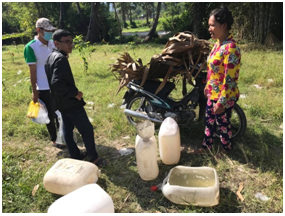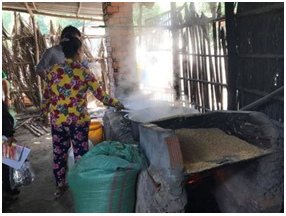Including Women’s voices in Exclusive Water Governance Institutions
- Duong Thanh

- Dec 15, 2020
- 3 min read
Updated: Jun 29, 2021
By Thai Huynh Phuong Lan
People living in rural areas across the Mekong Delta in Vietnam rely highly on natural resources for their livelihood and well-being. Women are a crucial part of the agricultural labour force in Vietnam and make an essential contribution to national economic development, but this is often not fully recognised by society. In 2014, 48 percent of the female workforce and 45 percent of the male workforce were engaged in agriculture, although much of this is part-time and women may be simultaneously involved in several economic sectors [1]. Women are often at the forefront of wetlands product gathering, processing and marketing activities, besides agriculture.

A woman harvesting mushrooms in Tinh Bien district, An Giang Province, Vietnam
Women are central actors in the cultivation, collection and sale of mushroom and other wetlands-linked products.
However, women often don’t have an adequate or equal voice in wetlands management institutions, both formal and informal, sometimes resulting from traditional gender stereotyping about women’s roles, social prejudices and cultural practices. According to a 2013 State Report to the CEDAW [2] Committee, “Vietnamese rural women are still less privileged than men. The primary reason lies in the unequal access to and control over key resources in agriculture, as well as the lack of gender sensitivity in agricultural services”.
Due to entrenched gender roles, women’s decision-making power over wetlands and water management at both the household and institutional levels is still limited. Because of a heavy burden of unpaid household and community duties, women’s access to vocational training and agricultural extension services, information, technology and credit is limited, which has a negative impact on women’s labour productivity in agriculture and off-farm sectors. The type of vocational training available to women is often short-term and biased towards ‘traditional’ women’s skills, that may not be so relevant to current demands within the economy [3].
A Khmer woman collecting palm juice and cooking palm sugar.
After her husband collects palm juice from the palm tree, she plays the main role in collecting palm juice home, cooking palm juice into palm sugar and selling products. Palm sugar is a traditional products of Khmer people and it is still a main source of income of many Khmer families in Tinh Bien district, An Giang Province, Vietnam.
In addition, women are expected to fulfill traditional gendered role in domestic duties involving water resources (e.g. laundry and washing up) and taking care of family members and the wider community. Even though being a main user of water resources, women are commonly excluded from committees and organisations managing water resources, from the local level upwards. The main reason is rooted in a social belief that water resource management is a highly technical field, better suited to the interests of men. Currently, women's participation in water governance is assessed only by the number of women present at meetings. When women participate in community water governance meetings, they often do not voice their opinions during the meetings and participate less when senior officials are involved. Poor ethnic women disproportionately experience exclusion from community water decision-making, in some cases due to language barriers. Most participants in science-technology transfer activities or irrigation management training courses are men. Heads of cooperatives and irrigation management groups are men, as are most local village and commune chiefs. Therefore, all local irrigation management institutions tend to be male dominated [4].
This present research project (acronym: BRIMOFOT) has been designed to understand the conditions and factors that lead to the existing under-representation of certain social groups in water and wetlands decision-making process and institutions, especially women. This project aims to identify and take positive steps to include these social groups in decision-making platforms to ensure improved social equity in wetlands and water resources management. It will begin by establishing baseline indicators of the present situation with regards to gender representation in wetlands-dependent communities of Takeo Province Cambodia and An Giang Province of Vietnam, from which any future changes can be compared against. It is expected that this project will lead to a substantial increase in the level of active participation of women and minority groups in wetlands decision-making processes and institutionsat several governance levels to ensure more socially equitable outcomes in longer term.
(NB: All photos taken by author)
References [1]https://www.vn.undp.org/content/vietnam/en/home/library/democratic_governance/gender-briefing-kit.html [2]The Convention on the Elimination of All Forms of Discrimination against Women. [3]https://www.vn.undp.org/content/vietnam/en/home/library/democratic_governance/gender-briefing-kit.html [4]https://www.sumernet.org/story/exploring-the-invisible-womens-voices-in-mekong-water-management-1
Read more at the official website of the BRIMOFOT project: https://brimofot.wixsite.com/offical
the BRIMOFOT: Bringing more than food to the table: precipitating meaningful change in gender and social equity-focused participation in trans-boundary Mekong Delta wetlands management.






Comments